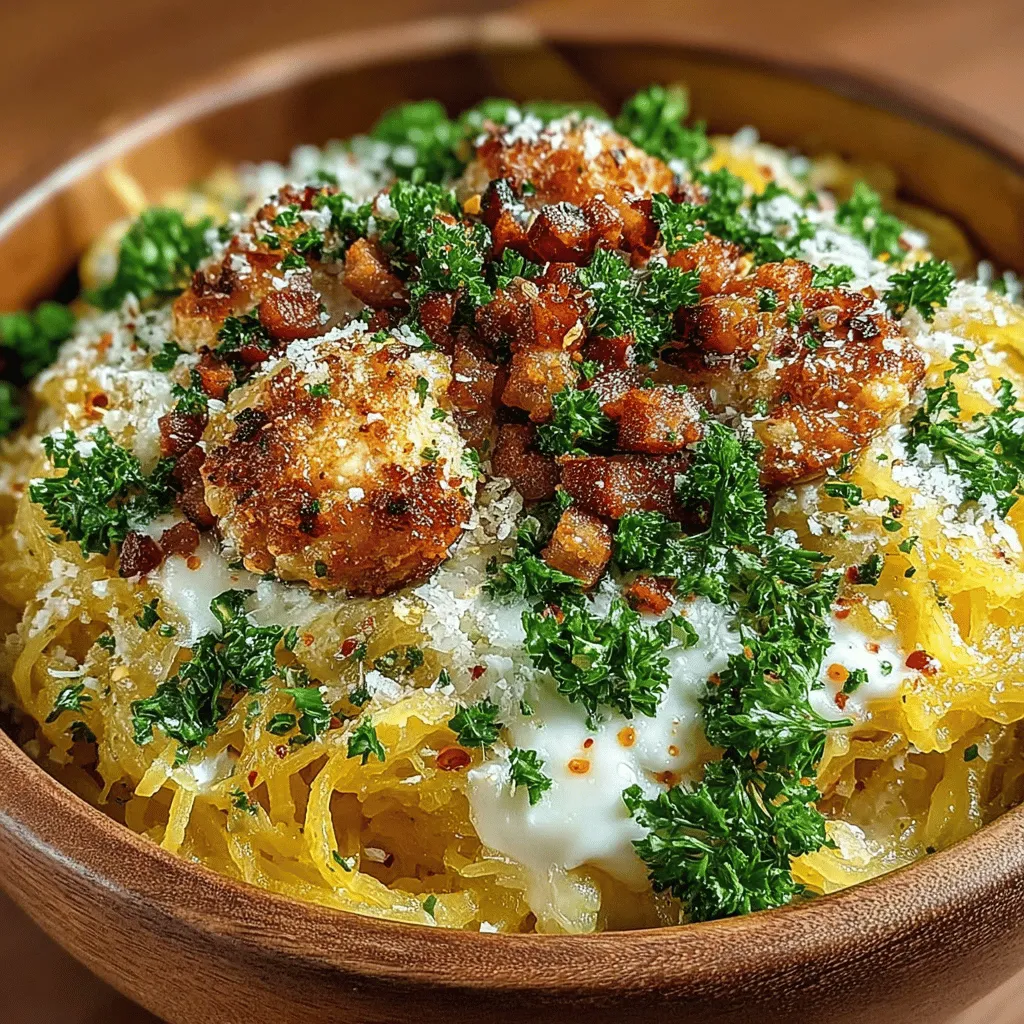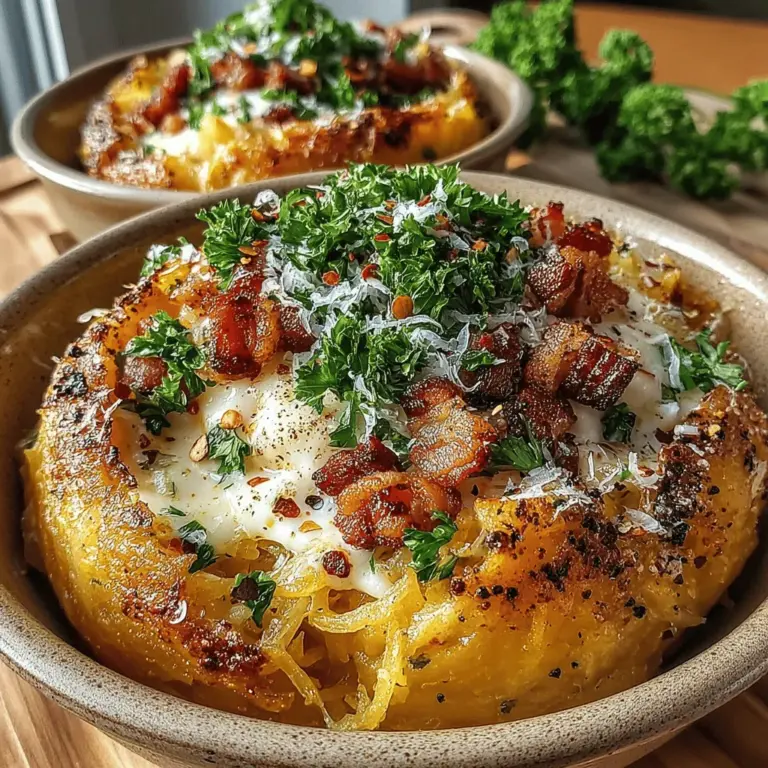Spaghetti Squash Carbonara Bowls: A Healthy Twist on a Classic Favorite
In recent years, spaghetti squash has surged in popularity as a wholesome alternative to traditional pasta. This unique vegetable, with its stringy flesh that mimics the texture of spaghetti, has captivated health-conscious eaters and culinary enthusiasts alike. It provides a satisfying base for a myriad of dishes, allowing those who desire a lighter option to enjoy their favorite meals without the added carbs. As a result, spaghetti squash has become a staple in the kitchens of many looking to reduce their carbohydrate intake while still indulging in delicious flavors.
One of the most iconic pasta dishes, carbonara, offers the perfect opportunity to marry the benefits of spaghetti squash with the rich, creamy goodness of the traditional recipe. Originating from Italy, carbonara is typically made with egg, cheese, pancetta, and pepper, resulting in a savory and comforting dish that has delighted palates for generations. By substituting spaghetti squash for traditional pasta, we can reinvent this classic recipe, creating Spaghetti Squash Carbonara Bowls that satisfy both pasta lovers and those seeking healthier meal options.
This dish appeals to a wide audience, from health-conscious eaters looking for low-carb alternatives to pasta aficionados who appreciate the rich, savory flavors of carbonara. The Spaghetti Squash Carbonara Bowl combines the best of both worlds, ensuring that no one has to compromise on taste or nutrition.
Understanding Spaghetti Squash
Spaghetti squash, a member of the gourd family, is characterized by its oval shape and vibrant yellow skin. When cooked, its flesh transforms into spaghetti-like strands, making it an excellent substitute for traditional pasta. Nutritionally, spaghetti squash is a powerhouse; it is low in calories yet rich in vitamins, minerals, and antioxidants. A single serving provides a significant dose of vitamin C, vitamin B6, and potassium while being an excellent source of dietary fiber. This combination not only supports digestive health but also promotes a feeling of fullness, making it an ideal choice for those seeking to lose weight or maintain a healthy lifestyle.
One of the primary reasons spaghetti squash stands out as a low-carb alternative is its remarkably low carbohydrate content compared to traditional wheat pasta. A cup of cooked spaghetti squash contains just around 10 grams of carbohydrates, while the same serving of regular pasta can have upwards of 40 grams. This makes spaghetti squash an exceptional choice for those following ketogenic, paleo, or diabetic diets, allowing them to enjoy their favorite dishes without the guilt traditionally associated with pasta.
In addition to its nutritional benefits, spaghetti squash is incredibly versatile in the kitchen. It can be roasted, steamed, or microwaved, allowing it to be incorporated into a variety of dishes ranging from casseroles to salads. The neutral flavor of spaghetti squash allows it to absorb the flavors of sauces and seasonings, making it a perfect canvas for creativity in culinary endeavors.
The Classic Carbonara: A Brief History
The origins of carbonara are somewhat shrouded in mystery, but it is widely believed to have originated in Rome during the mid-20th century. Traditionally, the dish is made with a few simple ingredients: spaghetti, eggs, hard cheese (like Pecorino Romano), cured pork (often pancetta or guanciale), and black pepper. The key to a perfect carbonara lies in the technique—cooking the pasta and mixing it with the egg and cheese to create a creamy, rich sauce without scrambling the eggs.
Over the years, various adaptations of carbonara have emerged, with many cooks adding cream or other ingredients to enhance the sauce’s richness. However, purists argue that the authentic Roman version should remain simple, relying on the quality of the ingredients to achieve the desired creamy texture.
This recipe for Spaghetti Squash Carbonara Bowls takes the essence of the classic carbonara and reimagines it in a healthier format. By using spaghetti squash instead of traditional pasta and incorporating wholesome ingredients, we can enjoy a beloved dish without straying from our health goals.
Ingredients Breakdown
To create the mouthwatering Spaghetti Squash Carbonara Bowls, you’ll need a selection of fresh, high-quality ingredients. Each component plays a crucial role in achieving the dish’s rich flavor and creamy texture.
– Spaghetti Squash: Selecting the right spaghetti squash is vital for a successful dish. Look for a squash that feels heavy for its size, with a firm exterior and no soft spots. Once you’ve chosen your squash, it can be stored in a cool, dry place for up to a month. When you’re ready to cook, slice it in half lengthwise, remove the seeds, and roast it in the oven until tender. This process transforms the flesh into the signature spaghetti-like strands.
– Pancetta vs. Bacon: Traditional carbonara calls for pancetta or guanciale, which provide an authentic flavor profile. Pancetta is an Italian cured meat made from pork belly, offering a rich, savory taste. If you’re unable to find pancetta, bacon can serve as a substitute, though it tends to be smokier and less nuanced. For a more authentic experience, look for unsmoked bacon or artisanal versions that mimic pancetta’s flavor.
– Garlic: Garlic is a staple ingredient that enhances the overall flavor of the dish. It adds a fragrant, aromatic quality that complements the richness of the pancetta and the creaminess of the sauce. Using fresh garlic cloves will provide the best flavor—simply mince or finely chop them to release their oils and essence before cooking.
– Fresh Eggs and Quality Parmesan Cheese: The heart of carbonara lies in the creamy sauce created by the emulsification of eggs and cheese. Using fresh, high-quality eggs is essential to achieving a luscious texture. Pair these with freshly grated Parmesan cheese, which contributes a salty, nutty flavor that enhances the overall dish. Be sure to avoid pre-grated cheese, as it often contains anti-caking agents that can affect the sauce’s creaminess.
– Heavy Cream and Seasonings: While traditional carbonara does not contain cream, adding a touch of heavy cream can elevate the sauce’s richness and ensure a velvety consistency. Seasoning the dish with salt and freshly cracked black pepper is essential, as these elements bring out the flavors of the dish without overpowering it.
– Optional Ingredients: For those who enjoy a bit of heat, consider adding red pepper flakes to the dish. This optional ingredient provides a subtle kick, balancing the richness of the carbonara and adding an extra layer of flavor.
With these ingredients in hand, you are well on your way to creating a delicious and healthy Spaghetti Squash Carbonara Bowl that is sure to impress both pasta lovers and those seeking lighter meal options. As we move forward, we’ll explore the cooking process and tips for assembling this delightful dish.

Step-by-Step Instructions
Preheating the Oven
Before diving into the preparation of your spaghetti squash, preheat your oven to 400°F (200°C). This temperature is crucial for roasting, allowing the squash to caramelize and develop its natural sweetness while achieving a tender texture. A properly preheated oven ensures even cooking and the best flavor profile for your dish.
Preparing the Spaghetti Squash
To prepare the spaghetti squash, start by selecting a medium-sized squash that feels heavy for its size. Begin by washing it thoroughly under running water. Next, using a sharp chef’s knife, slice the squash in half lengthwise. Exercise caution here, as the skin can be tough. Once halved, scoop out the seeds using a spoon to create a hollow cavity for roasting.
Season the inside of each half generously with olive oil, salt, and pepper. This seasoning will enhance the natural flavors of the squash. Optionally, you can add a pinch of garlic powder or Italian seasoning for an extra layer of flavor.
Roasting Process
Place the seasoned halves cut-side down on a baking sheet lined with parchment paper. Roast in the preheated oven for about 30-40 minutes. The squash is done when you can easily pierce the skin with a fork, and the flesh is tender yet firm. The goal is to achieve a slightly caramelized surface for depth of flavor without overcooking it.
Cooking Pancetta or Bacon
While the squash is roasting, it’s time to prepare the pancetta or bacon. Chop the pancetta into small cubes. In a large skillet over medium heat, add the pancetta and sauté until crispy, which usually takes about 5-7 minutes. Stir occasionally to ensure even cooking. If using bacon, follow the same method, adjusting the cooking time as necessary to achieve the desired crispness. The rendered fat will serve as the base for your carbonara sauce, infusing it with rich flavor.
Making the Carbonara Sauce
In a mixing bowl, whisk together 2 large eggs, 1 cup of grated Pecorino Romano cheese, and freshly cracked black pepper until well combined. The key to a successful carbonara sauce is the emulsion of the eggs and cheese. Ensure that the mixture is smooth and creamy, with no lumps. This will create the luxurious sauce that clings beautifully to the spaghetti squash strands.
Scraping the Spaghetti Squash
Once the squash has finished roasting, remove it from the oven and let it cool for a few minutes. Using a fork, scrape the flesh of the squash to create spaghetti-like strands. Be gentle during this process to avoid pulverizing the strands. Transfer the scraped squash into a large mixing bowl, ready to be combined with the pancetta and sauce.
Combining Ingredients
Now that you have your spaghetti squash and pancetta prepared, it’s time to combine them. Pour the crispy pancetta, along with its rendered fat, over the spaghetti squash strands. Immediately add the egg and cheese mixture, stirring vigorously to combine. The residual heat from the squash will cook the eggs gently, creating a creamy sauce without scrambling them. If the mixture seems too thick, a splash of reserved pasta water or additional olive oil can help achieve the desired consistency.
Tasting and Adjusting
Before serving, it’s essential to taste the dish and adjust the seasoning as needed. You may want to add more salt, pepper, or cheese depending on your preference. This final step is crucial to ensure that each bite is flavorful and balanced.
Serving Suggestions
Presentation Ideas
For an appealing presentation, serve the spaghetti squash carbonara in individual bowls. Garnish with a sprinkle of additional Pecorino Romano cheese, a twist of freshly cracked black pepper, and a few fresh parsley leaves for a pop of color. This not only enhances the visual appeal but also adds a fresh flavor contrast.
Pairing Suggestions
Pair your spaghetti squash carbonara with a crisp white wine, such as Pinot Grigio or Sauvignon Blanc, which complements the dish without overpowering it. Alternatively, a light, sparkling water with a slice of lemon can refresh the palate. For side dishes, consider a simple arugula salad dressed with lemon vinaigrette or roasted vegetables to round out the meal.
Variations to the Recipe
To adapt this recipe for different dietary needs, there are several variations you can consider:
– Vegetarian: Substitute pancetta with sautéed mushrooms or smoked tempeh for a savory, umami flavor.
– Gluten-Free: This recipe is naturally gluten-free, making it suitable for those with gluten sensitivities.
– Vegan: Replace the eggs and cheese with a combination of silken tofu blended with nutritional yeast for a creamy, plant-based sauce.
Nutritional Information
Spaghetti squash carbonara is not only delicious but also nutritious. A single serving typically contains approximately 300 calories, with 20 grams of protein, 15 grams of carbohydrates, and 22 grams of fat. This dish is rich in vitamins A and C, as well as fiber, making it a health-conscious choice compared to traditional carbonara, which can be significantly higher in calories and saturated fat due to the use of heavy cream and pasta.
Comparison with Traditional Carbonara
Traditional carbonara made with pasta typically ranges from 600-800 calories per serving due to the combination of pasta, eggs, cheese, and pancetta. By replacing pasta with spaghetti squash, you reduce the overall calorie count while increasing the vegetable content, making this dish a guilt-free indulgence.
Conclusion
Spaghetti squash carbonara bowls offer a delightful fusion of comfort food and healthy eating. With their rich flavors and creamy texture, they provide a satisfying alternative to traditional pasta dishes without compromising on taste. The incorporation of spaghetti squash not only enhances the nutritional profile but also caters to those looking for lighter meal options.
As you explore this recipe, embrace the versatility it offers. Whether you are preparing a weeknight dinner or hosting a gathering, spaghetti squash carbonara bowls are sure to impress. We encourage you to try this innovative dish, celebrating the joy of cooking while nourishing your body. Discover the deliciousness of spaghetti squash carbonara, and enjoy the journey of healthy culinary exploration.


